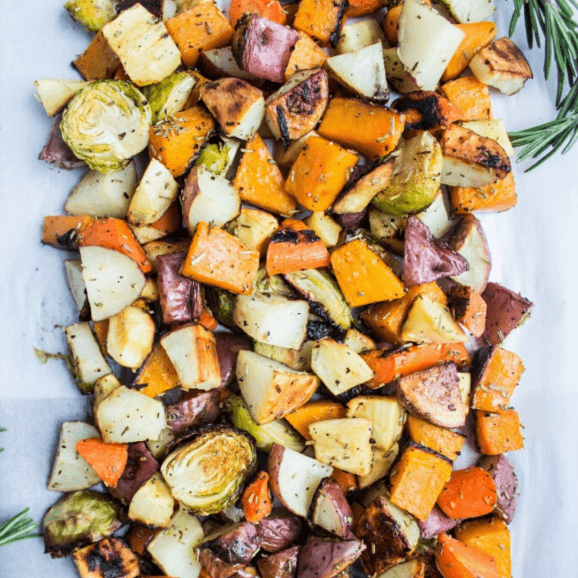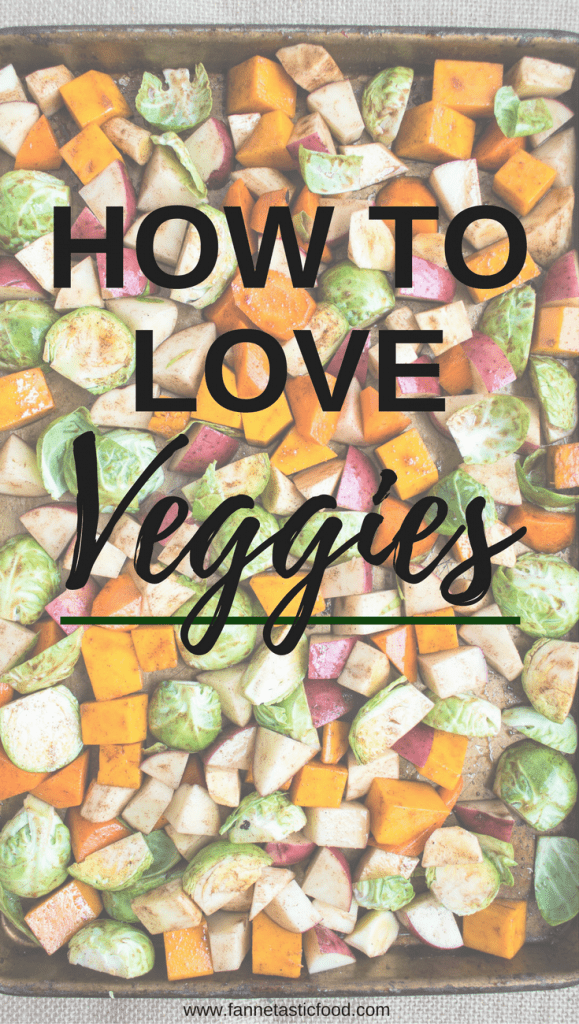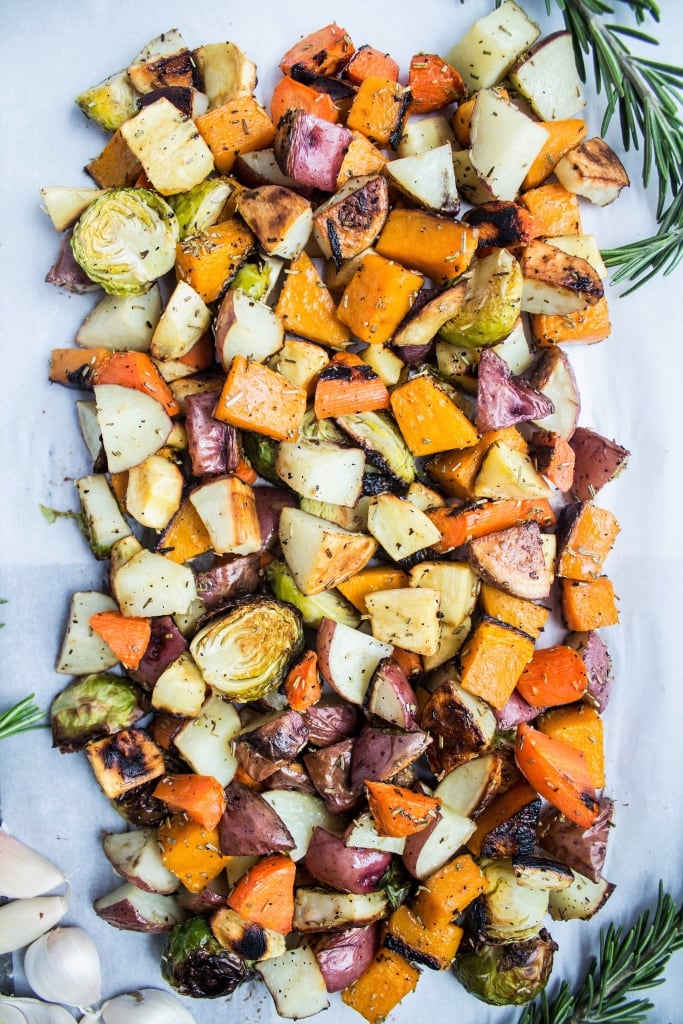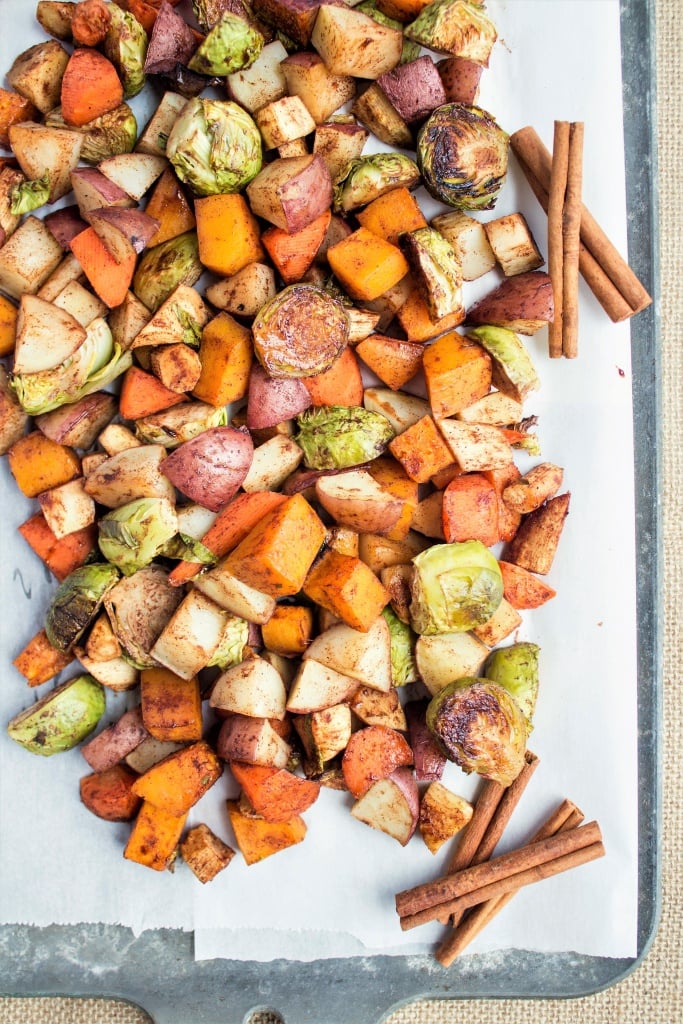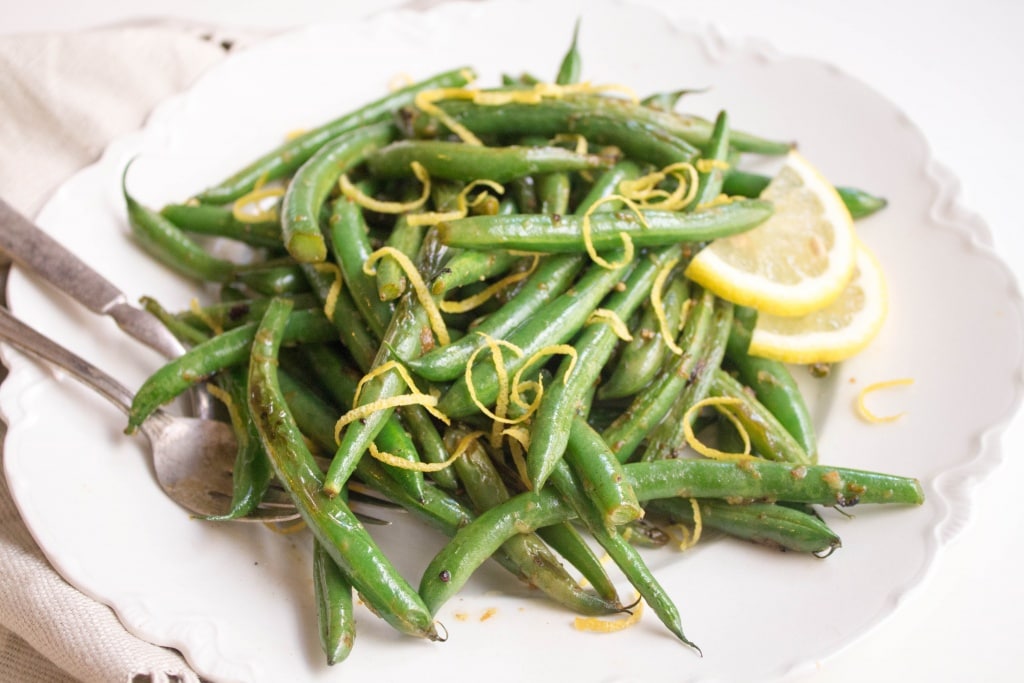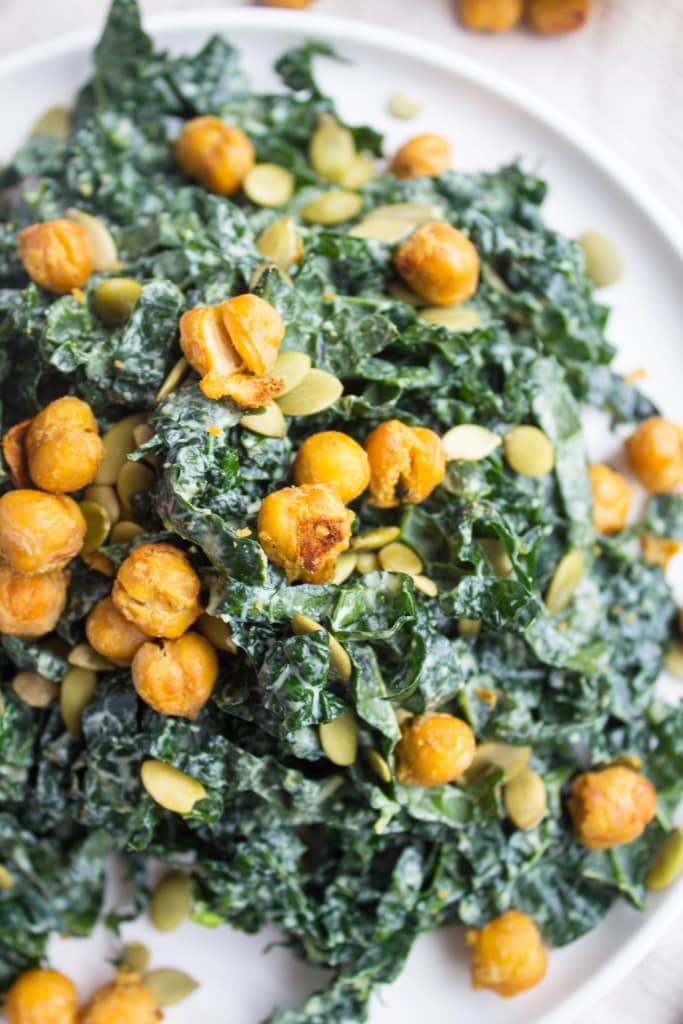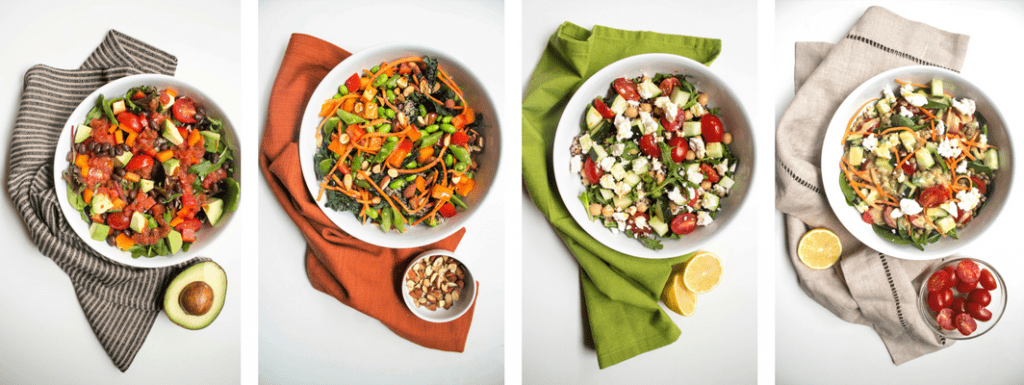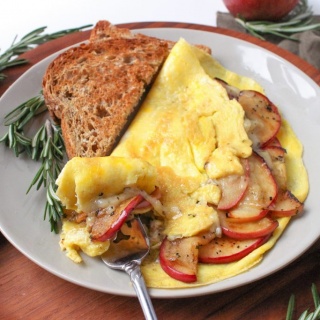Hello friends! I’m popping in today with some tips on how to love veggies (or at least not hate them).
I love veggies, but I know not everyone is excited to dig into a salad or a big pile of broccoli – and I get it! The main problem that I see nutrition clients and friends run into is not knowing how to prepare veggies in a way that makes them delicious. Because soggy, overcooked veggies and plain steamed veggies, or salads without good dressing = totally not delicious, and I wouldn’t want to eat them if that’s all I knew either.
You don’t have to love ALL veggies – but I hope this post may help you to find some new ways to enjoy them that you hadn’t thought of before!
Want to save this post?
Enter your email below and get it sent straight to your inbox. Plus, I'll send you great content every week!
The secret to loving veggies really boils down to just making them taste good. Here are my favorite ways to make veggies so delicious that you can’t help but fall in love with them.
1) Roast your Veggies
Roasted veggies are a thousand times more delicious than boiled/steamed veggies. Just sayin’!
Roasting is pretty much my go-to method for cooking veggies – it’s pretty hands-off, and it gets them nicely browned and caramelized so that they actually have more flavor! Think about the difference between eating a plain boiled potato and crispy roasted potato wedges – the latter definitely sounds more appealing to me, and the same goes for pretty much any vegetable!
(See also: How to Roast Frozen Vegetables + Recipe Ideas!)
Some of my favorite veggies to roast are broccoli, cauliflower, green beans, asparagus, and brussels sprouts. Getting a little color and crispiness on these veggies really amps up their flavor and makes them much more lovable. The method is simple, too. Just heat the oven to 400 degrees F, toss veggies in a drizzle of oil and a pinch of salt and pepper (plus whatever other spices you’d like), and roast until tender! (Hot tip: to easily evenly coat the veggies in oil, put the veggies in a ziplock bag, pour in some oil, and mix it around in there. Easier than trying to drizzle it on evenly when already in the pan!) I usually pull softer veggies like green beans and asparagus after 7-10 minutes, in-between veggies like brussels sprouts, broccoli, and cauliflower after 15-20 minutes, and harder root veggies like potatoes and parsnips after 20-25 minutes.
Looking for some flavor inspiration? Check out my Maple Cinnamon Roasted Veggies and Garlic Herb Roasted Veggies – both seasonings can be used on any combination of veggies you’re into! Also, check this post out: how to make brussels sprouts delicious. I used to make what I think is a common mistake when cooking brussels!
2) Don’t Shy Away from Seasonings
Like I said before, I’ve worked with so many clients who think that “eating veggies” means “eating plain, steamed veggies with nothing else on them.” That’s totally not the case – veggies don’t have to be boring. Bring on the spices!
Adding spices, herbs, and seasonings is the best way to add tons of flavor to veggies, and a well-stocked spice cabinet can go a long way in making your veggies taste great. Here are some of my favorite seasoning combinations:
- Ground cumin + chili powder (try this on my Mexican-Style Sweet Potato Fries or as a seasoning on just about any roasted veggie)
- Garlic + lemon zest (try this on my Lemon Garlic String Beans or on roasted or sauteed veggies – especially asparagus, broccoli, zucchini, and cauliflower!)
- Maple + cinnamon (try this on cozy fall/winter veggies like sweet potatoes, butternut or acorn squash, parsnips, brussels sprouts, and turnips – reference this post: Maple Cinnamon Roasted Veggies)
- Garlic + rosemary (this is great on just about any veggie! Perfect for roasted or sauteed veggies – reference this post: Garlic Herb Roasted Veggies)
- Pesto (try this in my Pesto Baked Salmon & Veggies or toss any veggie in pesto after roasting/steaming/sauteing, etc. It adds so much flavor!)
- Ginger + garlic + soy sauce (try adding this to stir-fried/sauteed veggies when they’re almost done cooking, or even on a sheet pan dinner like my Sheet Pan Asian Salmon with Veggies)
3) Make Salads Interesting
Just like how veggies with no seasoning aren’t always so lovable, salads with just lettuce and boring dressing aren’t likely to make you swoon. Here’s how to make salads more interesting while still keeping them veggie-heavy:
- Combine a variety of veggies. The key to a salad that keeps me interested is a variety of flavors, textures, and colors. I like to start out with greens and add crunchy fruits and veggies like peppers, carrots, celery, cucumbers, snap peas, or apples and juicy fruits and veggies like berries or tomatoes. The combination of textures and flavors is so much more interesting than just lettuce on a plate! Try my Mason Jar Kale Salad and Strawberry and Fennel Barley Salad for ideas that are chock full of different flavors and textures.
- Add crunch. In addition to adding crunchy veggies, I like to add extra crunch to keep me satisfied. Nuts and seeds like sliced almonds, chopped pecans and walnuts, pumpkin seeds, and more provide awesome crunch and a boost of healthy fats and nutty flavor for extra flavor and staying power. I also love crispy chickpeas on salads! They boost the protein and fiber so you stay full while adding lots of crunch. Try crispy chickpea “croutons” on my Vegan Kale Caesar Salad!
- Make a flavorful dressing. Some people just need a drizzle of olive oil and vinegar to get excited about salad, but I think a more flavorful dressing is the way to go! I always prefer homemade salad dressings, because they taste better, and since bottled ones can be loaded with sugar and other fillers. Homemade dressings are way easier to make than you think – try Homemade Balsamic Vinaigrette (<– seriously, so easy & yummy!) or Creamy Vegan Salad Dressing.
- Switch up your greens – and treat them right! If spring mix or romaine lettuce doesn’t excite you, don’t stop there! There are plenty of greens to choose from to mix up the flavors and textures in your salad. Arugula brings a spicy kick, romaine is nice and crunchy, spring mix and spinach are more tender, and kale is hearty and sturdy. Just make sure to treat your greens right – adding dressing to the mix too early will make lettuce and spinach soggy, but dressing kale in advance and massaging the dressing into it helps make it tender and delicious! If you’re not a fan of kale salads because of kale’s chewy texture, try dressing it in advance and I’m sure you’ll love how tender it gets.
- Add grains + protein for a full meal. My all-time favorite lunch is an easy grain salad bowl. When your greens and veggies are accented by grains, protein, healthy fats, and a fun dressing, it’s hard to get bored of them or wish for more flavor. The best part? The combinations are endless! Check out my post on Mix & Match Grain Salad Bowls for lots of ideas.
And if all else fails and you still aren’t feeling the veggies on their own, my last tip is to just serve some of your meals over microwave-wilted spinach. Just place a huge handful of fresh baby spinach on a plate, microwave for 45 seconds, and then add your meal on top. You won’t taste the spinach! Spinach is also great in smoothies – try my Banana Spinach Smoothie for a simple base that you can customize.
What are your favorite ways to eat veggies? Have you been successful in “converting” from a veggie-hater to a veggie-lover?


